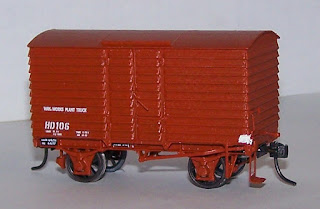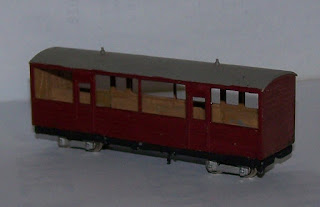Looking through my collection of photos recently I stumbled across some of my earlier build projects before I started this blog (which was 5 years ago).
Ok let's begin.
Now at first glance you may think this is a
Steam Era Models Explosives P-van and you would be correct....to a point.The underframe and the decals were certainly sourced from such a kit, but the body is a different matter. I cannot remember exactly who produced it but the body is in fact a one-piece casting and represents the Series 2 vans (the SEM kit represents the first 25 made). It has different end bracing. It was painted up to look like P43 which is part of the VGR fleet. The model was built in August 2010 and still looks like this today (I need to replace those spoked wheels with disc ones one day).
Next one:
Now this is a SEM kit. It is the B-van but with a difference. I decided to have a go at making the prototype B-van which had flat ends rather than the ribbed style of the majority of the fleet. This involved shaving off the detail and replacing the end bracing with styrene strip. I was still playing around with colours to represent VR wagon red at the time and those with a sharp eye will note there is in fact two colours on this van. I originally painted it with Aussie Export 'Terracotta' in the spray can but it came out too light. So I gave the model a light coat of another red (cannot remember what shade sorry) and as a result it came out looking a bit like a tomato. I also built this model in 2010 but sold it some time ago. I do want to do another one in the future and I will be able to use the experience I gained making this one to do a better version.
Next model:
Now this one nearly drove me round the bend. It is a SEM Rail Tractor. I had bought the kit a couple of years before but it took a while to get the courage up to build it (wasn't too flash when it came to soldering things either). I had previously tried building a WT water tank and it was a epic fail (which I still have and it may get a photo on here one day just for laughs) and a QB well wagon (which I put together with super glue and it apparently is still holding together). When doing these kits it is recommended to do the WT first to get some experience, then the QB and then the RT. Well I didn't strictly do that and while the model turned out ok I would probably do a couple of things different today. Again built in 2010 and is still in limited service as, like the real ones, it doesn't haul much.
Next one:
This is a
Blue and Gold Models CS-van as used on the 'Spirit Of Progress' train. Originally this kit was released by G&E Models some years ago but was re-released by Blue and Gold Models. Bogies are the Powerline ones that came out with the original Powerline S cars in the early 1990s and the yellow lining soured from VR-Enthusiast. The paint used was the Humbrol acrylic spray cans (#15 which is what I still use for VR blue, just in the tinlets these days). It does make the job of painting quicker but the cost of these cans is pretty expensive (at the time it was about $10 for a 150ml can). I could not find my photos of it before the paint went on, but the body is cast in the 'Milky Bar' Polyurethane with the doors and some detail parts being etched brass. Again made in 2010.
Next:
This is a Broad Gauge Bodies (BGB) V&SAR Joint Stock sleeping car. Cast in the 'Milky Bar' Polyurethane like the CS-van. I built it as 'Tambo' which is preserved at Maldon these days but with alterations to the lounge end (the ends with the one larger side window) to make it larger and a end platform installed. I choose to represent the prototype in colours but not form so it retains the original look, right down to the Overland signs and the mirrors above the side windows. It was fitted with a set of SEM E-car bogies when first built but recently I replaced them with a set of Auscision E-car bogies with the 'VR' lettering cast into the sideframes but have still yet to put an interior in it. Another model from 2010.
Next:
Another BGB kit. This time it is a CW-van. Same 'Milky Bar' Polyurethane as the previous couple of models. Constructed in 2010 and painted with Aussie Export red spray paint (not a bad match for VR pass red). I have been thinking about repainting this model in recent years as most of my timber cars are painted in the earlier Crimson Lake livery. I also need to make up the steps to go under the small doors at the same time...perhaps.
Next:
SEM 3-door QR wagon. This model was new for 2010 and the first injection moulded styrene kit to be produced by SEM since the L-type sheep wagon in 2003. It was built and painted in a matter of weeks. This was when I moved to painting wagons with the SEM VR wagon red paint by brush (not recommended BTW). It came out not bad. It represents QR272 as preserved by the VGR who are presently restoring the prototype to service.
Next:
This is a
Strath Hobbies MF bogie cattle wagon. The kit was purchased in 2012 and completed in early 2013. Uses SEM bogies as well as the wagon ends/roof from the 4-wheel M-van. Strath supply cast sides and underframe to make it. I had to fabricate my own side-steps from brass wire. Shunter's steps are SEM and the handbrake is from Model Etch. Painted to represent MF1, again preserved by the VGR.
Next:
Now this is an old kit. It is a Scaleways 4-door QR wagon. Purchased in 2010 I believe but not built until 2013. The model required the door bump strips to be made (using styrene strip), a couple of handrails fitted, shunters steps and bogies from SEM and a handbrake from Model Etch. It was coded as a VOWA purely because the QR code decals fell apart and I had spare VOWA ones from building the SEM kit of the 3-door version.
Last one:
This is a SEM GY-wagon. This kit was re-released in 2010 with a few improvements to the detail (the original GY kit dated back to the Broad Gauge Models days and was released back in 1982). I opted to change the axlebox lids to the round type which involves filing off some of the detail for the flap-type lids. Painted with SEM paints (before I gave up on painting with them by brush) and numbered as GY15933 which again is preserved by the VGR.
Well I hope you enjoyed this little 'throw-back' of some of my earlier projects. As you can see the Victorian Modeller has been well looked-after when it comes to kits of rollingstock for a number of years. It is important to try and keep the hobby going by supporting them otherwise they may not be around in years to come.



















































